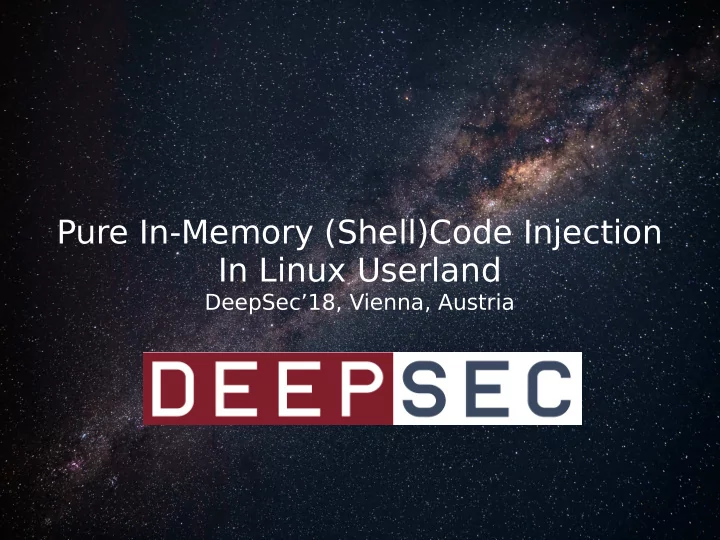

Pure In-Memory (Shell)Code Injection In Linux Userland DeepSec’18, Vienna, Austria
Disclaimer The views and opinions expressed in this presentation are those of the author and do not necessarily represent offjcial policy or position of my employer or of its clients.
about(me); $ fjnger -l $USER Login name: reenz0h In real life: reenz0h Directory: /home/sweeTHome Shell: /usr/bin/ipython Last login Fri Jun 29 22:21 on rawttyS0 from ::1 Unread mail since T ue Feb 14 23:40:24 2017 Plan: * Senior Security Researcher / Red T eamer @ Big Company * Former (sys|net) engineer * Speaker/Trainer * Organizer of x33fcon security conference, Gdynia, Poland * Founder/CEO of Sektor7 research company
agenda(DeepSec); * Problem Description * Common Code Execution w/ Artifacts * Communication Channels (IB/OOB) w/ compromised system * In-Memory-Only Methods - Live Demos * OPSEC considerations * References
#defjne PROBLEM; * Scenario: - breached into a Linux system; - access to interactive shell w/ or w/o allocated PTY; - post-exploitation activities w/ additional tools; * Objective: - run extra tools w/o touching disk; - use only what is available on compromised system; - optionally bypass noexec fmag set on partitions;
#redefjne PROBLEM; Living ofg the land… MacGyver style
send_payload(victim); Communication channels (methods to deliver payloads): * “Out-Of-Band”: network protocols/sockets (uni|multi|broad|any-cast), internal/extrenal devices * “In-Band”: TTY as a data link
In-Memory-Only Methods
shellcode(DEMO); The following shellcode will be used during DEMO sessions.
mount(tmpfs); NAME tmpfs - a virtual memory fjlesystem DESCRIPTION The tmpfs facility allows the creation of fjlesystems whose contents reside in virtual memory. Since the fjles on such fjlesystems typically reside in RAM, fjle access is extremely fast.
mount(tmpfs);
execve(gdb); DESCRIPTION [...] GDB can do four main kinds of things (plus other things in support of these) to help you catch bugs in the act: · Start your program, specifying anything that might afgect its behavior. · Make your program stop on specifjed conditions. · Examine what has happened, when your program has stopped. · Change things in your program, so you can experiment with correcting the efgects of one bug and go on to learn about another.
execve(gdb); DEMO
gdb(POC);
execve(python); Use CTYPES to run your shellcode in memory: * load libc; * mmap() new W+X memory region for shellcode * copy shellcode into mmap’ed bufger * make the bufger ‘callable’ * make the call * profjt...
execve(python); DEMO
python(POC);
dd(procfs); NAME dd - convert and copy a fjle DESCRIPTION Copy a fjle, converting and formatting according to the operands. ------------------------------------------------------------------------------------------------ NAME proc - process information pseudo-fjlesystem DESCRIPTION The proc fjlesystem is a pseudo-fjlesystem which provides an interface to kernel data structures.
dd(procfs); This translates to: “Make dd modify itself on the fmy” But… 2 problems: stdin and stdout; ASLR
dd(procfs); Problem #1: dd closes stdin and stdout Solution: dup()
dd(procfs); Problem #2: ASLR
dd(procfs); Solution: change execution domain (aka personality ) DESCRIPTION Linux supports difgerent execution domains, or personalities, for each process. Among other things, execution domains tell Linux how to map signal numbers into signal actions. The execution domain system allows Linux to provide limited support for binaries compiled under other UNIX-like operating systems. […] ADDR_NO_RANDOMIZE (since Linux 2.6.12) With this fmag set, disable address-space-layout randomization.
dd(procfs); T urning ASLR ofg at runtime (from userland):
dd(procfs); Write-What(Shellcode)-Where? PLT? Risky ...
dd(procfs); DEMO
dd(POC);
call(MOAR_POWER); Shellcode is kinda cool, but coding complicated stufgs in asm is a PITA. We want to run an executable (ELF object). So…
mkfjfo(); Fails… mmap() cannot fjnd target fjle to load.
memfd_create(); SYNOPSIS #include <sys/memfd.h> int memfd_create(const char *name, unsigned int flags); DESCRIPTION memfd_create() creates an anonymous fjle and returns a fjle descriptor that refers to it. The fjle behaves like a regular fjle, and so can be modifjed, truncated, memory-mapped, and so on. However, unlike a regular fjle, it lives in RAM and has a volatile backing storage. Once all references to the fjle are dropped, it is automatically released. [...] The memfd_create() system call fjrst appeared in Linux 3.17; glibc support was added in version 2.27.
memfd_create(); Shellcode:
memfd_create(); DEMO
memfd_create(POC);
opsec(); * Logs * Process list * Swappiness - mlock(), mlockall(), mmap() - CAP_IPC_LOCK || root + ulimits - sysctl vm.swappiness / /proc/sys/vm/swappiness - root - cgroups (memory .swappiness) - root || priviledge to modify cgroup + does not guarantee that under heavy load memory manager will not swap the process to disk anyway (ie. root cgroup allows swapping and needs memory)
bottom_line(); Be like MacGyver
exit(“Thank you”); Questions? twitter: @x33fcon https://www.x33fcon.com https://www.sektor7.net
call(references); * The Design and Implementation of Userland Exec by the grugq https://grugq.github.io/docs/ul_exec.txt * Advanced Antiforensics : SELF by Pluf & Ripe http://phrack.org/issues/63/11.html * Implementation of SELF in python by mak https://github.com/mak/pyself * Linux based inter-process code injection without ptrace(2) by Rory McNamara https://blog.gdssecurity.com/labs/2017/9/5/linux-based-inter-process-code-injection-without- ptrace2.html
Recommend
More recommend